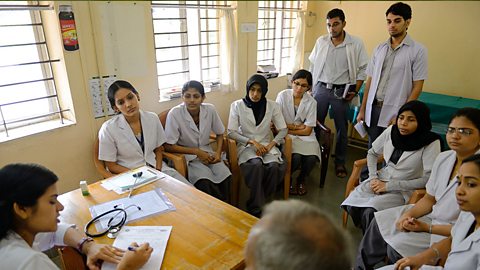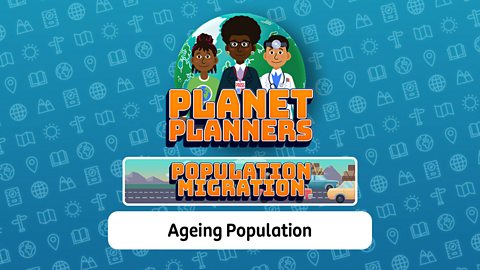What do you know?
What does the word population mean?
Population means the number of people living in a certain area.
Key Points
- Population is influenced by birth rateA measurement of the number of live births in a country. Usually given as a figure per 1,000 people per year.and death rateThe number of deaths per 1,000 people per year..
- Population changes can be shown on a Demographic Transition Model (DTM).
- There are different ways of managing population such as encouraging people to have more or fewer children or limiting birth rates by law.
Game - Ageing population
Play a Planet Planners mission and help a country to prepare for the effects of an ageing population.
You can also play the full game
Population change
Video: Measuring population
Find out about how and why we measure population
YENG: How and why do we measure population?
Hi, I'm Yeng.
I work in the Public Health and Insight team at Coventry City Council.
We work with organisations and residents to improve the health and well-being of our community.
LIGHT MUSIC
We do this by using population data which gives us lots of information about people living in the area.
The data helps us make decisions on what local services are needed, and where. For example, new housing, providing access to green spaces and supporting people with disabilities. It also allows us to monitor how society is changing over time.
One of the best ways to measure population is through the Census survey.
In the UK the census happens every 10 years.
Every household, by law, must answer the same set of questions on the same day.
The information provides a snapshot of the lives of everyone living in the UK.
The data sets are vital to the government and local councils to plan for new schools and hospitals and to allocate funding to people who need it the most.
Knowing how the population is changing means I can make a real difference to the health and well-being of the community.
MUSIC CONTINUES
Changes in population
The populationThe number of people living in a certain area. of a country changes over time. These changes are caused by three factors - births, deaths and migrationThe movement of people from one permanent home to another..The change in population caused by births and deaths is called natural changeThe difference between births and deaths in a population.. The population will get larger or smaller depending on birth rateA measurement of the number of live births in a country. Usually given as a figure per 1,000 people per year. and death rateThe number of deaths per 1,000 people per year.. If the birth rate is higher than the death rate there will be a natural increaseWhen birth rates are higher than death rates and the population increases.. If the death rate is higher than the birth rate there will be a natural decreaseWhen more people are dying than babies being born..
Population is also affected by migration. Migration includes both immigrationEntering a country with the intention of living there for at least a year. , when people move to a country, and emigrationLeaving a country with the intention of living in another country for at least a year. , when people move away from a country.
Question
What is meant by the term natural increase?
Natural increase means that the population is increasing as more babies are being born than people are dying.
The Demographic Transition Model (DTM)
Changes in population are usually closely linked to the developmentThe progress of a country in terms of wealth and human well-being. of a country and can be illustrated by the Demographic Transition Model (DTM). The DTM shows the relationship between birth rates and death rates and population, but not migration.
The DTM can be split into five stages:
Stage one – Population is low but there are high birth and death rates.
Stage two – Population begins to increase as death rates fall due to improvements in medicine and sanitation. Birth rates remain high.
Stage three – Population is still increasing but more slowly now as birth rates fall due to increased access to contraception and familyplanning, improvements in health education and a general desire for smaller families. Death rate continues to fall but at a slower rate than at stage two.
Stage four – Population is now high but as birth rates and death rates are now low, the rate of population change is steadier than before.
Stage five – Population may start to decline at this point due to low birth rates and an ageing population leading to a slight increase in death rates.
Activity: Demographic Transition Model
Learn more about the different stages of the Demographic Transition Model with this activity.
Quiz: Demographic Transition Model
Question
At what stage of the Demographic Transition Model are high birth rates but falling death rates likely?
Stage two of the Demographic Transition Model is characterised by high birth rates but falling death rates.
Quiz: Population change
Population pyramids
When looking at population, structure as well as total numbers is important. This means looking at the number of people in each age group and how those numbers are changing. These are known as population pyramids. Countries at different stages of the DTM have different shaped population pyramids.
The interpretation of a population pyramid can help a geographer understand the structure of a country, for example:
- a wide base to the pyramid indicates a young population
- wider bars at the top of the pyramid indicate an ageing population
There may be anomalyData which is significantly different than what is expected and that doesn't fit the overall pattern. in the pyramid, for example:
- a longer than expected bar may indicate a large amount of immigration at that age range
- a shorter than expected bar may be due to war or famine
Population pyramid for Kenya
Population pyramid for Japan
Population pyramid for the United Kingdom
Population pyramid for United Arab Emirates
Question
What does a wide base on a population pyramid indicate?
A wide base to the pyramid indicates a young population.
Quiz: Population pyramids
How do countries manage their population?
Governments sometimes create policies to manage their population. They may try to increase birth rates, and therefore the population, by encouraging people to have children through pro-natal policiesPolicies designed to increase the birth rate. . Alternatively, they may try to decrease the birth rate, and slow the rate of population growth, by discouraging people from having children through anti-natal policiesPolicies designed to decrease the birth rate..
United Kingdom

Pro-natal strategies are used in the United Kingdom to try and boost fertility rateThe number of children that an average woman gives birth to. Fertility rates tend to be higher in LICs than in HICs.. These include incentives such as child benefit payments, free childcare, and improved maternity and paternity leave. There are also family-friendly employment laws such as the right to request flexible hours and job sharing.

China
In the 1970s, China attempted to reduce the country's birth rate and slow the population growth by introducing the one-child policy whereby families could only have one child. The policy did slow population growth but also had some negative impacts. The policy led to a decrease in human rights because people were not allowed to make decisions about the size of their families. China now has an ageing population which threatens to slow economic growth as the number of working-age people decreases. China has made some changes to their policy and, as of 2021, families are now allowed to have three children.
Kerala, India

The state of Kerala in India also faced high population growth. This was creating many problems, such as overcrowding and a shortage of food. The government have now slowed this population growth through a mixture of contraception use and the introduction of government policiesA course of action taken by a government. to improve education and healthcare, especially for women. Improvements in education have also led to infant mortality rates falling. This has meant that Kerala has managed to control its population growth without restrictions on family size.

Question
Which country introduced a one-child policy in the 1970s?
China introduced a one-child policy in the 1970s to try to reduce the country’s birth rate and slow population growth.
Play the Planet Planners game! gamePlay the Planet Planners game!
Make decisions for the planet in this KS3 geography game.

More on Population and migration
Find out more by working through a topic
- count2 of 2

